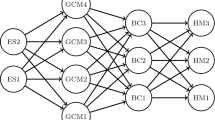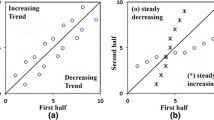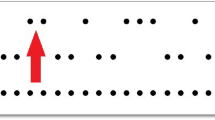Abstract
There is a considerable uncertainty in a hydrological projection, which arisen from the multiple stages composing the hydrological projection. Uncertainty decomposition analysis evaluates contribution of each stage to the total uncertainty in the hydrological projection. Some uncertainty decomposition methods have been proposed, but they still have some limitations: (1) they do not consider nonstationarity in data and (2) they only use summary statistics of the projected data instead of the full time-series and lack a principled way to choose the summary statistic. We propose a novel Bayesian uncertainty decomposition method which can alleviate such problems. In addition, the proposed method provides probabilistic statements about the uncertainties. We apply the proposed method to the streamflow projection data for Yongdam Dam basin located at Geum River in South Korea.
Similar content being viewed by others
Notes
Throughout this article, we refer to selected emission scenarios, GCMs, bias correction techniques and hydrological models as “simulators” to simplify sentences, e.g., we write “simulator uncertainties” instead of “model/scenario/technique uncertainties”.
This result is valid for the scenario period. For the control period, we use an observed emission scenario and thus have 60 (\(=5\times 3\times 4\)) projected values.
References
Amireche, M., Merabtene, T., Bermad, A., & Boutoutaou, D. (2017). Comparative assessment between gr model and tank model for rainfall-runoff analysis using kalman filter-application to algerian basins. In MATEC Web of Conferences (vol. 120, pp. 05006). EDP Sciences.
Bastola, S., Murphy, C., & Sweeney, J. (2011). The role of hydrological modelling uncertainties in climate change impact assessments of irish river catchments. Advances in Water Resources, 34(5), 562–576.
Beven, K., & Binley, A. (1992). The future of distributed models: Model calibration and uncertainty prediction. Hydrological Processes, 6(3), 279–298.
Bosshard, T., Carambia, M., Goergen, K., Kotlarski, S., Krahe, P., Zappa, M., et al. (2013). Quantifying uncertainty sources in an ensemble of hydrological climate-impact projections. Water Resources Research, 49(3), 1523–1536.
Buser, C. M., Künsch, H. R., Lüthi, D., Wild, M., & Schär, C. (2009). Bayesian multi-model projection of climate: Bias assumptions and interannual variability. Climate Dynamics, 33(6), 849–868.
Collins, W., Bellouin, N., Doutriaux-Boucher, M., Gedney, N., Halloran, P., Hinton, T., et al. (2011). Development and evaluation of an Earth-System model-HadGem2. Geoscientific Model Development, 4(4), 1051.
Dobler, C., Hagemann, S., Wilby, R., & Stötter, J. (2012). Quantifying different sources of uncertainty in hydrological projections in an alpine watershed. Hydrology and Earth System Sciences, 16(11), 4343–4360.
Hidalgo, H. G., Dettinger, M. D., & Cayan, D. R. (2008). Downscaling with constructed analogues: Daily precipitation and temperature fields over the United States. California Energy Commission PIER Final Project Report. CEC-500-2007-123.
Hörmann, W., & Leydold, J. (2014). Generating generalized inverse gaussian random variates. Statistics and Computing, 24(4), 547–557.
Jo, S., Kim, G., & Jeon, J.-J. (2016). Bayesian analysis to detect abrupt changes in extreme hydrological processes. Journal of Hydrology, 538, 63–70.
Katz, R. W. (2010). Statistics of extremes in climate change. Climatic Change, 100(1), 71–76.
Kelley, C. P., Mohtadi, S., Cane, M. A., Seager, R., & Kushnir, Y. (2015). Climate change in the fertile crescent and implications of the recent Syrian drought. Proceedings of the National Academy of Sciences, 112(11), 3241–3246.
Kim, Y., Ohn, I., Lee, J.-K., & Kim, Y.-O. (2019). Generalizing uncertainty decomposition theory in climate change impact assessments. Journal of Hydrology X, 3, 100024.
Kuczera, G., & Mroczkowski, M. (1998). Assessment of hydrologic parameter uncertainty and the worth of multiresponse data. Water Resources Research, 34(6), 1481–1489.
Lee, S., Kim, J., & Hur, J. W. (2013). Assessment of ecological flow rate by flow duration and environmental management class in the Geum River, Korea. Environmental Earth Sciences, 68(4), 1107–1118.
Lettenmaier, D. P., & Gan, T. Y. (1990). Hydrologic sensitivities of The Sacramento-San Joaquin River basin, California, to global warming. Water Resources Research, 26(1), 69–86.
Mandal, S., & Simonovic, S. P. (2017). Quantification of uncertainty in the assessment of future streamflow under changing climate conditions. Hydrological Processes, 31, 2076–2094.
Maurer, E. P. (2010). The utility of daily large-scale climate data in the assessment of climate change impacts on daily streamflow in California. Hydrology and Earth System Sciences, 14, 1125–1138.
Minville, M., Brissette, F., & Leconte, R. (2008). Uncertainty of the impact of climate change on the hydrology of a nordic watershed. Journal of Hydrology, 358(1), 70–83.
Moore, J. K., Lindsay, K., Doney, S. C., Long, M. C., & Misumi, K. (2013). Marine ecosystem dynamics and biogeochemical cycling in the community earth system model [cesm1 (bgc)]: Comparison of the 1990s with the 2090s under the rcp4. 5 and rcp8. 5 scenarios. Journal of Climate, 26(23), 9291–9312.
Mudersbach, C., & Jensen, J. (2010). Nonstationary extreme value analysis of annual maximum water levels for designing coastal structures on the German North Sea coastline. Journal of Flood Risk Management, 3(1), 52–62.
Nijssen, B., O’donnell, G. M., Hamlet, A. F., & Lettenmaier, D. P. (2001). Hydrologic sensitivity of global rivers to climate change. Climatic Change, 50(1–2), 143–175.
Nóbrega, M., Collischonn, W., Tucci, C., & Paz, A. (2011). Uncertainty in climate change impacts on water resources in the Rio Grande Basin, Brazil. Hydrology and Earth System Sciences, 15(2), 585.
Perrin, C., Michel, C., & Andréassian, V. (2003). Improvement of a parsimonious model for streamflow simulation. Journal of Hydrology, 279(1), 275–289.
Pierce, D. W., Das, T., Cayan, D. R., Maurer, E. P., Miller, N. L., Bao, Y., et al. (2013). Probabilistic estimates of future changes in California temperature and precipitation using statistical and dynamical downscaling. Climate Dynamics, 40(3–4), 839–856.
Serafin, K. A., & Ruggiero, P. (2014). Simulating extreme total water levels using a time-dependent, extreme value approach. Journal of Geophysical Research: Oceans, 119(9), 6305–6329.
Smith, R. L., Tebaldi, C., Nychka, D., & Mearns, L. O. (2009). Bayesian modeling of uncertainty in ensembles of climate models. Journal of the American Statistical Association, 104(485), 97–116.
Sugawara, M. (1979). Automatic calibration of the tank model/l’étalonnage automatique d’un modèle à cisterne. Hydrological Sciences Journal, 24(3), 375–388.
Sunyer, M. A., Madsen, H., Rosbjerg, D., & Arnbjerg-Nielsen, K. (2014). A bayesian approach for uncertainty quantification of extreme precipitation projections including climate model interdependency and nonstationary bias. Journal of Climate, 27(18), 7113–7132.
Tebaldi, C., & Sansó, B. (2009). Joint projections of temperature and precipitation change from multiple climate models: a hierarchical bayesian approach. Journal of the Royal Statistical Society: Series A (Statistics in Society), 172(1), 83–106.
Tebaldi, C., Smith, R. L., Nychka, D., & Mearns, L. O. (2005). Quantifying uncertainty in projections of regional climate change: A bayesian approach to the analysis of multimodel ensembles. Journal of Climate, 18(10), 1524–1540.
Watanabe, S., Hajima, T., Sudo, K., Nagashima, T., Takemura, T., Okajima, H., et al. (2011). Miroc-esm 2010: Model description and basic results of cmip5-20c3m experiments. Geoscientific Model Development, 4(4), 845.
Weitzman, M. L. (2009). On modeling and interpreting the economics of catastrophic climate change. The Review of Economics and Statistics, 91(1), 1–19.
Wood, A. W., Leung, L. R., Sridhar, V., & Lettenmaier, D. (2004). Hydrologic implications of dynamical and statistical approaches to downscaling climate model outputs. Climatic Change, 62(1), 189–216.
Yip, S., Ferro, C. A., Stephenson, D. B., & Hawkins, E. (2011). A simple, coherent framework for partitioning uncertainty in climate predictions. Journal of Climate, 24(17), 4634–4643.
Yukimoto, S., Adachi, Y., Hosaka, M., Sakami, T., Yoshimura, H., Hirabara, M., et al. (2012). A new global climate model of the meteorological research institute: Mri-cgcm3—model description and basic performance. Journal of the Meteorological Society of Japan. Ser. II, 90, 23–64.
Acknowledgements
This work was supported by Korea Environmental Industry & Technology Institute(KEITI) through Advanced Water Management Research Program, funded by Korea Ministry of Environment (Grant no. 83082).
Author information
Authors and Affiliations
Corresponding author
Additional information
Publisher's Note
Springer Nature remains neutral with regard to jurisdictional claims in published maps and institutional affiliations.
Appendix A. Bias correction techniques
Appendix A. Bias correction techniques
In this section, we briefly explain bias correction steps in BCSD and BCCA. For more details, we refer to Pierce et al. (2013) and Maurer (2010).
BCSD starts with monthly GCM output (e.g., temperature or precipitation). BCSD first removes the linear trend in the GCM data over years in each month and then applies the quantile mapping to the detrended data for each month. Through the quantile mapping, the GCM output value z is adjusted to the bias corrected value \({\hat{z}}\) as
where \(F_m\) and \(F_o\) denote the cumulative distribution functions of the GCM output and the observed data, respectively. In practice, \(F_m\) and \(F_o\) usually assumed to be in a parametric family, for example, normal distribution for temperature and gamma distribution for precipitation, and their parameters are determined for each month based on the GCM ouput data and the observed data in the control period, respectively. Lastly BCSD added the subtracted linear trend back to the adjusted GCM output through the quantile mapping.
BCCA is almost identical to BCSD, but the quantile mapping is applied to the daily data instead of the monthly data. BCCA does not remove the linear trend in the data since the motivation for trend removal is not strong for daily data. The cumulative distribution functions of the GCM output and the observed data are estimated from the GCM output values and observed data in the control period, respectively, for each month.
Rights and permissions
About this article
Cite this article
Ohn, I., Kim, S., Seo, S.B. et al. Bayesian uncertainty decomposition for hydrological projections. J. Korean Stat. Soc. 49, 953–975 (2020). https://doi.org/10.1007/s42952-019-00042-8
Received:
Accepted:
Published:
Issue Date:
DOI: https://doi.org/10.1007/s42952-019-00042-8










